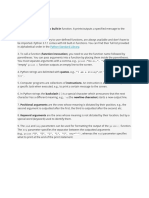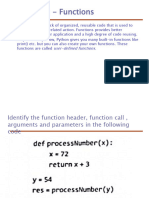0 ratings0% found this document useful (0 votes)
11 viewsPython Module Notes
python - pcep notes exam
Uploaded by
MuthuuCopyright
© © All Rights Reserved
We take content rights seriously. If you suspect this is your content, claim it here.
Available Formats
Download as DOCX, PDF, TXT or read online on Scribd
0 ratings0% found this document useful (0 votes)
11 viewsPython Module Notes
python - pcep notes exam
Uploaded by
MuthuuCopyright
© © All Rights Reserved
We take content rights seriously. If you suspect this is your content, claim it here.
Available Formats
Download as DOCX, PDF, TXT or read online on Scribd
You are on page 1/ 1
- A function is an independent segment of code that can produce an effect,
compute a value (result), and take arguments.
- The `print()` function can accept one or more arguments. Python mandates
that only one instruction can be placed on a single line.
- An empty `print()` call outputs a blank line or a newline.
- When `print()` is used with multiple arguments, it displays them all on the
same line.
- The `print()` function automatically inserts a space between the arguments it
outputs.
- Arguments passed to `print()` are handled in a positional manner.
- A keyword argument is made up of three parts: a keyword identifying the
argument (e.g., `end`), an equals sign (`=`), and the value assigned to it.
- All keyword arguments must come after the last positional argument (this is
crucial).
- Python 3.8 includes 69 built-in functions.
- The process of using a function is known as a function invocation or function
call.
- Computer programs consist of sets of instructions, with each instruction being a
command that performs a specific task, such as printing a message to the
screen.
- Keyword arguments are defined by a specific word (keyword) that identifies
them, so their meaning is not determined by their position in the code.
You might also like
- Programming Essentials in Python - SlideplayerNo ratings yetProgramming Essentials in Python - Slideplayer54 pages
- Jcs2201-Python Programming Unit-IV NotesNo ratings yetJcs2201-Python Programming Unit-IV Notes27 pages
- 4 Python Functions, Modules and PackagesNo ratings yet4 Python Functions, Modules and Packages13 pages
- Functions in Python - Practice Problems by CPSNo ratings yetFunctions in Python - Practice Problems by CPS25 pages
- Unit - Iv: UNIT - IV Syllabus: Functions - Defining Functions, Calling Functions, PassingNo ratings yetUnit - Iv: UNIT - IV Syllabus: Functions - Defining Functions, Calling Functions, Passing14 pages



























































